
Rangers’ latest Europa League campaign resumes tomorrow night when they play the first leg of their last-16 tie with Benfica in Lisbon.
According to Philippe Clement, for the first time since he assumed the manager’s job at Ibrox Rangers are the underdogs, against a team that spent close to 100million euros in the summer and boasts plenty of elite talent.
What is Benfica’s tactical identity, where are they weak and can Rangers secure a result?
Coming into the game off the back of a bruising 5-0 defeat at the hands of rivals Porto and having scraped through the Europa League play-off round via two penalties to beat Toulouse 2-1 on aggregate, Benfica’s stop-start season has shown little sign of relenting since the turn of the year. On the basis of xG (not including penalties) the Portuguese side only shaded things 2.64 to 2.52 in the previous round.
Roger Schmidt won the Portuguese Championship last season and his side trail city rivals Sporting Lisbon by only a point at the time of writing. Benfica spent heavily in the most recent summer window acquiring the likes of Angel Di Maria, Orkun Kokcu from Feyenoord, Arthur Cabral from Fiorentina and Marcos Leonardo from Santos.
Schmidt’s team has rarely found a settled balance, however. Although the likes of Di Maria, Joao Mario, 19-year-old midfielder Joao Neves, Rafa Silva, Nicolas Otamendi and Antonio Silva have been consistent features, issues at full-back and the attack have led to plenty of changes.
Juan Bernat and David Jurasek were signed to compete for the left-back slot last summer but the former is injured and the latter on loan at Hoffenheim having struggled to settle. That’s led to Morato (a conventional centre-back) and on-loan 20-year-old Alvaro Carreras filling in on that side of the defence.
On the right, Alexander Bah has also struggled with injury and missed the weekend’s loss to Porto. Often that’s led to Fredrik Aursnes, a midfielder, filling in at right-back.
Benfica play a variation of a 4-2-3-1 shape that changes depending on personnel, with Schmidt’s side normally defending in a 4-4-2 shape. Full-backs are the width providers although Di Maria and David Neres can also operate in the wide zones of the pitch. Expect to see the Portuguese side line-up with a narrow attacking unit and wide full-backs in most phases.
Notice, during Benfica’s home tie with Toulouse, a double-pivot midfield of Kokcu and Neves, Mario narrow from a left-sided starting position and Rafa Silva central alongside No.9 Cabral. The pass network charts average passing positions.
In the away tie, with a lower possession share of 53 percent compared to 58 in the first leg, Di Maria and Neres operated slightly wider. Notice the high positioning of No.10 Silva in relation to the side’s forward Casper Tengstedt.
It’s common to see Tengstedt operate as a wider forward with a No.10 running beyond (he set up all three of Joao Mario’s goals in a 3-3 draw against Inter) with Cabral a focal point at No.9.
Joao Neves, 19, and Antonio Silva, 20, are both regulars at the base of midfield and centre-back. They, alongside each full-back, are tasked with carrying a large portion of the pitch defensively and in transition to compensate for an attacking midfield selection.
Benfica’s attacking set-up can take up a narrow form with Schmidt tasking attackers to play in combination, start in positions where they can easily press and regain the ball as well as, obviously, attack closer to goal.
Take the best chance of their away trip to Toulouse, a 0.71xG opportunity for Di Maria. Look at the set-up with the wide wing-backs in yellow, the attacking four in pink and the midfield pair highlighted in white.
In the below GIF, notice the attack remaining narrow and right-back Bah providing width with a driving run. Di Maria’s late run into the box nearly ends in a goal.
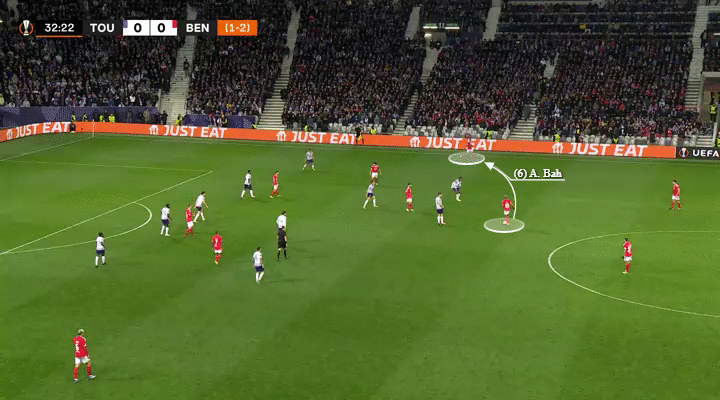
Here’s a strike from their 3-3 draw with Inter in the Champions League group stage which has a similar look, notice again a double pivot at the base of midfield, two wide, flying full-backs and a narrow attacking four.
Di Maria slides a ball into Silva, who’s a nimble ball carrier in tight areas, and he in turn is able to find Tengstedt in the pocket. A gap opens up as Inter’s left-wing back, Augusto, is pulled wide by the forward run of Aursnes from right-back.
Mario, after Tengstedt gets a break of the ball, can make a late run into the box to head home unmarked.
Mario, who scored a hat-trick on that day, has a habit of making these late runs into the box.
When the dangerous Rafa Silva, Mario and Di Maria access space in central areas they’re a constant threat given their individual quality, strength of finishing and elite ability. Benfica are clearly incredibly strong from middle to front, but are there areas of the pitch Rangers can target?
During the Champions League group stage, Benfica averaged 1.84xG conceded/90, the third-worst total in the entire group stage. Schmidt’s side also allowed the second-highest shot quality against (0.12xG/Shot conceded/90) and had the fourth-worst defensive output from corners (0.41xG conceded/90).
For all the individual and collective talent in their team, there are clear weaknesses off the ball that Rangers could target to try and reach the Europa League quarter-finals.
The system deployed by Schmidt requires Neves to cover an abundance of ground in the centre and each full-back to do the same, providing width while trying to balance out the counterattacking threat of opponents firing passes down the side of the defence.
Benfica’s weak spot defensively arrives when opponents can create a two-vs-one against each full-back which, as will become obvious, is not a rare trend. Given Benfica play wingers who think forward first, and require full-backs to provide width, they concede plenty of goals in this area.
Toulouse, as outlined above, were very unfortunate to not score from 2.07xG in the home leg of the previous round. It was notable just how often they managed to create a five-vs-four across the Benfica backline with their wing-backs. Di Maria is often caught ball-watching in scenarios like the one below.
Here are a few more examples of teams exploiting Benfica’s lack of cover at the back post.
In their recent 2-1 defeat to city rivals Sporting, look at Benfica’s lack of numbers at the back post in the below GIF as Pedro Goncalves makes a late run off of Di Maria again to score.
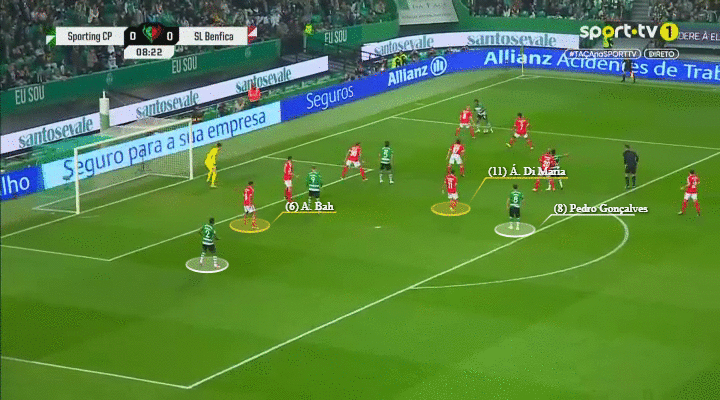
Although the goal they allowed at home against Toulouse took a deflection. David Neres, the left winger in this scenario, is out of the picture initially and eventual goalscorer Mikkel Desler, pushing forward from wing-back, again creates the overload.
The goal comes as the visitors create a two-vs-one against the full-back on each side.
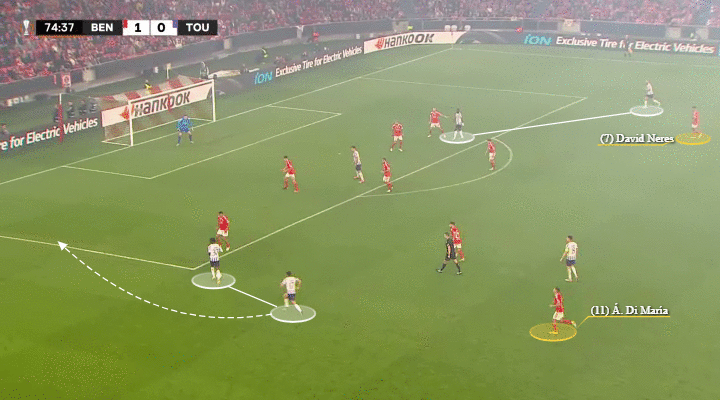
Inter Milan’s second goal in a thrilling 3-3 group stage draw was similar. This time their goalscorer, Davide Frattesi, exploits the gap between the centre-back and full-back. Simply, Benfica’s defence lacks support from the midfield.
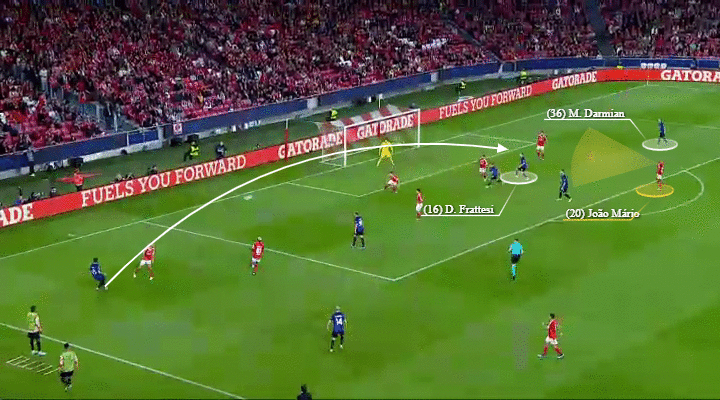
Finally, in Porto’s recent 5-0 demolition job, again notice that Benfica’s wingers are nowhere to be seen as their opponents create overloads on each side to score in injury time.
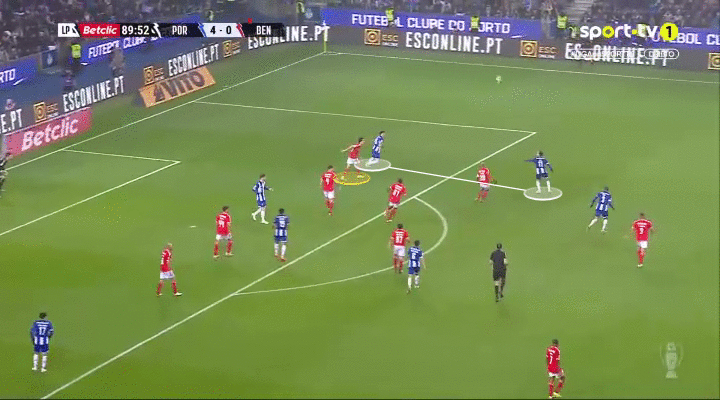
As Clement suggests, Rangers are underdogs for a reason in this tie. Benfica have players who need only an inch to punish you and keeping that narrow attacking quartet quiet will be far from easy.
However, there is hope for the Ibrox side. If they’re able to capitalise on Benfica’s defensive weaknesses, a pattern seen all throughout the season, goals in this tie should not be ruled out.















Comments: Our rules
We want our comments to be a lively and valuable part of our community - a place where readers can debate and engage with the most important local issues. The ability to comment on our stories is a privilege, not a right, however, and that privilege may be withdrawn if it is abused or misused.
Please report any comments that break our rules.
Read the rules here